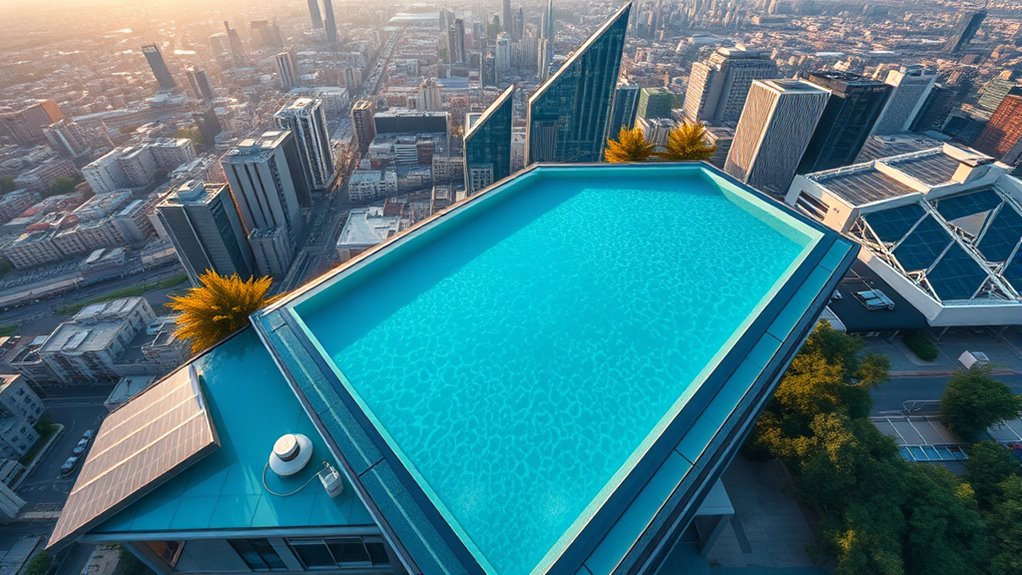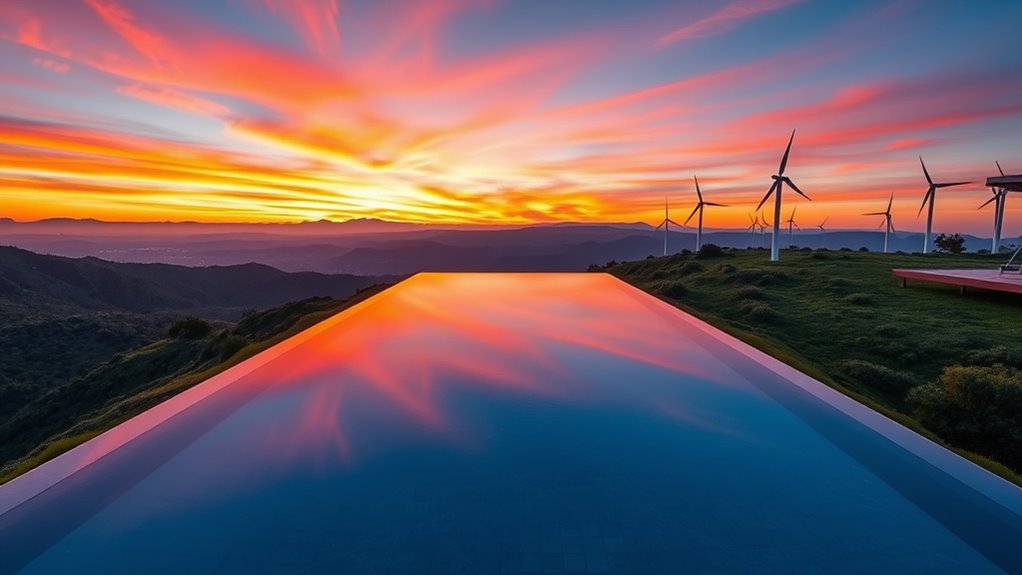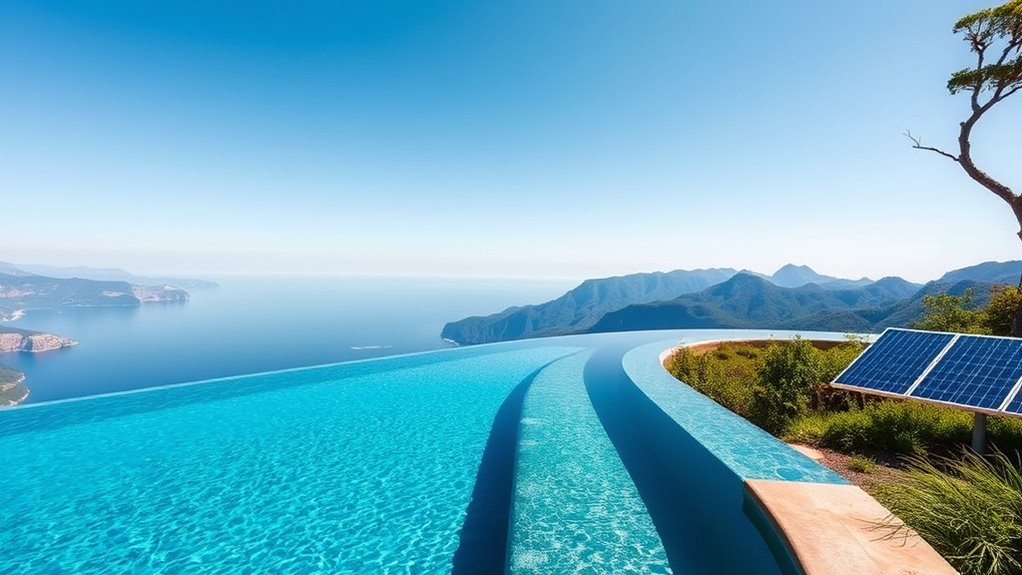Infinity pools can have a significant environmental impact due to their high water and energy use, as well as material consumption during construction. They require continuous filling, chemical treatments, and maintenance, which can harm local ecosystems and wildlife. To minimize your footprint, consider eco-friendly options like solar heating and sustainable materials. Want to learn how to enjoy luxury responsibly? Keep exploring ways to make your infinity pool more environmentally friendly.
Key Takeaways
- Infinity pools require large water volumes, leading to significant water consumption and potential strain on local resources.
- Continuous evaporation and chemical treatments can harm ecosystems through water loss and chemical runoff.
- High energy use for heating, filtration, and lighting increases greenhouse gas emissions and carbon footprint.
- Construction materials and waste contribute to habitat disruption, pollution, and resource depletion.
- Responsible maintenance and eco-friendly technologies can mitigate environmental impacts while maintaining luxury features.
Water Consumption and Conservation Challenges

Have you ever considered how much water infinity pools consume? These luxurious features require a significant amount of water to fill and maintain. Since they’re often designed with large, open edges that create the illusion of merging with the environment, they tend to use more water than traditional pools. You might think about the frequent refilling needed due to evaporation, splashing, and filtration processes. This continuous water loss poses a challenge for conservation efforts, especially in areas experiencing drought or water shortages. To mitigate this, pool owners can adopt measures like covering pools when not in use, installing efficient filtration systems, and recycling water. Despite these efforts, the sheer volume of water used in infinity pools remains a notable environmental concern.
Energy Use and Carbon Footprint

Infinity pools often require substantial energy to operate, from maintaining water circulation and filtration systems to powering lighting and heating elements. This high energy demand results in a significant carbon footprint, especially if the electricity comes from fossil fuels. The heating systems, in particular, consume large amounts of energy to keep the water at a comfortable temperature year-round. Additionally, lighting features used for aesthetic purposes increase power consumption during nighttime hours. As a result, the overall environmental impact of an infinity pool extends beyond water use, contributing to greenhouse gas emissions. If sustainability is a concern, you might consider integrating energy-efficient equipment, solar power systems, or automation controls to reduce energy use and minimize your pool’s carbon footprint. Implementing renewable energy sources can further lessen the environmental impact of maintaining an infinity pool.
Materials and Construction Impacts

Constructing an infinity pool involves significant material consumption and environmental impacts. You’ll need large quantities of concrete, steel, and waterproofing materials, which require energy-intensive manufacturing processes. Extracting raw materials causes habitat disruption, resource depletion, and pollution. The construction process itself generates waste, dust, and emissions that contribute to air and soil contamination. Additionally, heavy equipment used during building consumes fossil fuels, increasing your overall carbon footprint. The choice of materials affects the pool’s longevity and recyclability; using non-sustainable options can lead to further environmental strain when repairs or decommissioning occur. To minimize impacts, you should consider sourcing eco-friendly materials, optimizing design to reduce material needs, and working with contractors committed to sustainable practices. Incorporating environmentally responsible construction methods can further reduce the ecological footprint of your infinity pool project.
Maintenance and Chemical Usage

Maintaining an infinity pool requires regular chemical treatment to keep the water safe and clear, which can have environmental consequences. You often use chlorine or other disinfectants, and excess chemicals can leach into nearby soil and waterways, affecting local ecosystems. Overuse of chemicals can also produce harmful byproducts that persist in the environment. Additionally, balancing pH levels and adding algaecides or clarifiers increases chemical demand and waste. You might also run pumps and filtration systems frequently, consuming significant energy. This ongoing chemical and energy use contributes to pollution and resource depletion. To minimize impact, you should adopt eco-friendly practices, such as using less chemicals, opting for alternative sanitizers, and maintaining equipment efficiently. Proper chemical management is essential to reduce the environmental footprint of your infinity pool, and understanding environmental impact can help in making sustainable choices.
Impact on Local Ecosystems and Wildlife

The chemicals used to keep your infinity pool safe and clear can have far-reaching effects on the surrounding environment. When these chemicals leak or runoff, they enter nearby soil and water sources, disrupting local ecosystems. Wildlife that drinks from contaminated water or feeds on aquatic plants may experience health issues or behavioral changes. Fish and amphibians are especially vulnerable to chemical imbalances, which can cause population declines. Additionally, chemical residues can harm native plant species, reducing biodiversity. The disruption of natural habitats can lead to a decline in species diversity and weaken the resilience of local ecosystems. Moreover, proper chemical management is essential for minimizing environmental impact and maintaining ecological balance, as advancements in water treatment technologies can reduce harmful runoff. As a result, your pool’s chemical management directly influences the health of wildlife and the stability of surrounding natural environments.
Sustainable Alternatives and Innovations

To reduce the environmental impact of infinity pools, many designers and homeowners are turning to sustainable alternatives and innovative technologies. You can consider using eco-friendly materials like recycled glass tiles or low-impact concrete. Solar-powered pumps and filtration systems help cut energy use, while rainwater harvesting reduces reliance on municipal water. LED lighting and smart controls optimize energy efficiency. Here’s a quick overview:
| Technology/Method | Benefit |
|---|---|
| Solar-powered pumps | Lower energy consumption |
| Recycled materials | Reduce environmental footprint |
| Rainwater harvesting | Conserves freshwater |
| LED lighting | Uses less energy |
| Smart filtration systems | Enhances efficiency and sustainability |
Implementing energy-efficient technologies ensures your infinity pool remains luxurious while minimizing its ecological footprint. These innovations make your infinity pool more eco-conscious without sacrificing aesthetics or luxury.
Designing for Environmental Responsibility

Designing an infinity pool with environmental responsibility in mind means integrating sustainable principles from the outset. You should select eco-friendly materials that minimize resource use and reduce environmental impact. Incorporate energy-efficient systems, like solar-powered pumps and LED lighting, to lower electricity consumption. Water conservation is also key; consider implementing recycling systems or using smart sensors to optimize water flow and reduce waste. Location matters—choose sites that require minimal landscaping or excavation to preserve natural habitats. You can further improve sustainability by designing for easy maintenance, reducing chemical use, and promoting natural filtration methods. Additionally, understanding water quality and flow rate considerations can help optimize system efficiency and longevity. By prioritizing these design choices, you ensure your infinity pool not only enhances aesthetics but also minimizes its ecological footprint from the very beginning.
Cost-Benefit Analysis of Luxury Features

When considering luxury features for infinity pools, you weigh the financial investment against the added value they bring. Think about whether the environmental trade-offs, like increased energy or water use, justify the enhanced experience. Ultimately, you need to assess if the benefits align with your sustainability goals and budget. Incorporating ethical considerations into your decision-making process can help ensure that your luxury features are both environmentally responsible and aligned with your values.
Financial Investment vs. Value
While infinity pools add a striking visual appeal, they often come with hefty price tags that prompt homeowners to weigh their worth carefully. You need to consider whether the luxury features justify the investment. The initial costs can be substantial, including construction, maintenance, and energy expenses. If you’re seeking long-term value, evaluate how much enjoyment, prestige, or potential property appreciation they deliver. Sometimes, the aesthetic allure doesn’t translate into real financial gains, especially if upkeep becomes burdensome. You should also compare these costs with alternative features that might offer similar satisfaction at a lower price. Ultimately, appraising whether the emotional and aesthetic benefits outweigh the financial outlay helps you make a smarter, more informed decision about investing in an infinity pool. Additionally, understanding the environmental impact of such features can help ensure your luxury choice aligns with sustainable living.
Environmental Trade-offs Considered
Considering the environmental impact of infinity pools requires a careful cost-benefit analysis that balances luxury with sustainability. You need to weigh the advantages of aesthetic appeal and relaxation against ecological costs. Here are key trade-offs to deliberate:
- Water consumption: Infinity pools often use large volumes of water, which can strain local resources.
- Energy use: Pumps, filtration, and heating increase energy demands, raising carbon footprints.
- Material impact: Construction materials like glass and concrete have significant environmental footprints.
- Maintenance chemicals: Chemicals used for water treatment can harm local ecosystems if not managed properly.
- The integration of AI in infrastructure can optimize resource use and reduce environmental impacts associated with luxury features like infinity pools.
Tips for Eco-Friendly Infinity Pool Ownership

Owning an infinity pool responsibly means making intentional choices that minimize environmental impact. First, opt for energy-efficient pumps and lighting to reduce electricity use. Consider installing a solar heating system to harness renewable energy and cut down on fossil fuel consumption. Regularly maintain water levels to prevent overfilling and waste. Use eco-friendly, non-toxic pool chemicals to avoid harming local ecosystems. Cover your pool when not in use to minimize evaporation, conserving water and reducing chemical needs. Additionally, incorporate natural landscaping around your pool to reduce runoff and promote biodiversity. Embracing attention in creative practice can also help you stay mindful of sustainable habits and innovations. Finally, educate yourself on sustainable practices and stay informed about eco-friendly innovations. By implementing these tips, you can enjoy your infinity pool while actively reducing its environmental footprint.
Frequently Asked Questions
How Do Infinity Pools Affect Local Water Tables?
Infinity pools can lower local water tables because they constantly need water to fill and maintain the level. When you top off the pool, you use groundwater or surface water, which can reduce the amount available for nearby wells and natural sources. Over time, this excessive water use may lead to a decline in local water tables, especially in areas already facing water scarcity.
What Are the Long-Term Environmental Costs of Infinity Pools?
Imagine telling your grandchildren about the glamorous infinity pool you built, but it comes with long-term costs. You might see increased water use, chemical runoff, and energy consumption that harm ecosystems over time. These pools can contribute to water scarcity and pollution if not managed responsibly. While luxurious now, their environmental footprint could last for generations, making it essential to weigh beauty against sustainability for future generations.
Are There Eco-Friendly Chemicals Specifically for Infinity Pool Maintenance?
Yes, there are eco-friendly chemicals designed for infinity pool maintenance. These products often use natural enzymes, mineral-based sanitizers, or non-toxic compounds that minimize environmental harm. By choosing biodegradable and low-impact chemicals, you can keep your pool clean without releasing harmful substances into the environment. Regular testing and maintenance also help reduce chemical use, ensuring your infinity pool remains eco-friendly while providing safe, clear water for you to enjoy.
How Do Infinity Pools Influence Local Biodiversity?
Infinity pools can harm local biodiversity by disrupting natural water flow and attracting wildlife that may struggle with altered habitats. You might notice fewer native species around your pool area, as the artificial environment favors certain organisms over others. To minimize this impact, you should use eco-friendly chemicals, maintain proper water levels, and create buffer zones with native plants. These steps help protect local ecosystems while enjoying your luxurious infinity pool.
Can Solar-Powered Infinity Pools Be Cost-Effective?
Yes, solar-powered infinity pools can be cost-effective over time. You’ll save on energy bills since solar panels harness free, renewable energy from the sun. Although initial setup costs might be higher, incentives and decreasing panel prices make it more affordable. Plus, you’ll reduce your carbon footprint and dependence on traditional energy sources. Over several years, the savings and environmental benefits often outweigh the upfront investment, making it a smart, eco-friendly choice.
Conclusion
While infinity pools shimmer like mirages on the horizon, their environmental toll can cast shadows over natural beauty. By choosing sustainable materials, conserving water, and embracing eco-friendly innovations, you can transform your luxury retreat into a haven of harmony with nature. Remember, the true luxury lies not just in grandeur, but in nurturing the world around you. Let your pool be a mirror reflecting responsible stewardship, turning opulence into a legacy of environmental respect.









